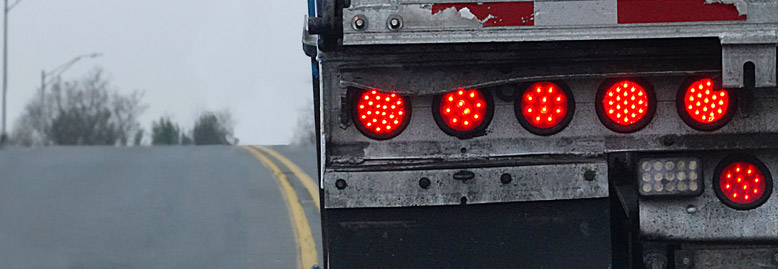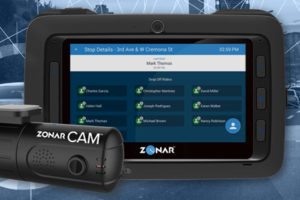Don’t be an out-of-service statistic. Here’s what you need to know to protect yourself:
The goal of Brake Safety Week is to reduce the number of crashes caused by poorly maintained braking systems on commercial motor vehicles (CMVs) by conducting roadside mechanical fitness inspections and identifying and removing vehicles with critical brake violations from our roadways.
Properly functioning brake systems are crucial to safe CMV operation. CMV brakes are designed to hold up under tough conditions, but they must be routinely inspected and maintained carefully and consistently so they operate and perform properly throughout the vehicle’s life. Improperly installed or poorly maintained brake systems can reduce braking efficiency and increase the stopping distance of trucks and buses, posing serious risks to all highway users and public safety. Antilock braking systems help the vehicle, and thus the driver, maintain control in certain situations, which reduces the risk of some types of crashes.
During this year’s Brake Safety Week,
According to the Federal Motor Carrier Safety Administration’s data snapshot in the Fall of 2018, out of 2.38 million total inspections, 1.04 million were cited for brake-related violations in federal fiscal 2018.
During Brake Safety Week, inspectors will primarily conduct the North American Standard Level I Inspection with a focus on brake hoses/tubing which is part of a 37-step procedure that includes an examination of both driver operating requirements and vehicle mechanical fitness. Inspections conducted will include inspection of brake-system components with attention to eight specific features
- Checking the air brake mechanical components
- Checking the steering axle air brake mechanical components
- Checking the brake adjustment
- Building the air system’s pressure to 90-100 psi
- Checking the antilock braking system (ABS) if applicable
- Testing the air loss rate, if necessary
- Testing the low air pressure warning device
- Checking the tractor protection system
What to remember:
- Inspections will take place September 15-21, 2019
- During the 2018 Brake Safety Week, just over 14% of inspected vehicles were placed out of service, according to the CVSA. (DON’T BE A STATISTIC)
- The minimum braking efficiency for trucks is 43.5 percent, required by U.S. federal
regulation and the CVSA out-of-service criteria - Repairs and defects that lead to inspection violations are preventable with Zonar EVIR®—the only patented, verifiable, electronic inspection system on the market today
The good news is roadside inspections don’t have to be a pain and drivers can get through them fairly quickly. As long as they keep a few things in mind before they get behind the wheel of their vehicle, a proper inspection can save drivers and fleet managers a lot of grief in the long run. Here’s a few things that can help make the CVSA Roadcheck program and your next inspection far less of a burden
Appearances Matter
While the old adage states that you should never judge a book by its cover, the truth is a visual scan can tell a trooper quite a bit about the state of a vehicle. Most inspections are at discretion and if the outside of a truck and the cab is clear and everything seems to be in good working order, then the natural assumption is that a driver is responsible enough to look after his vehicle. Drivers should make sure their lights are working, their tires aren’t damaged and their cargo is secured. Of course, a driver doesn’t have to break out the Windex or keep everything spotless but knowing where their documents are goes a long way in getting through an inspection quickly.
Be Aware of Common Pitfalls
Remember the number five. There are five common levels of inspection and five common violations that can take a vehicle off the road. Knowing what each list entails can save a driver and fleet manager money and time dealing with repairs and lost miles.
The five levels of inspection are:
- Level One is the most common and comprehensive inspection. This includes a thorough vehicle and paperwork review. Only a Level One inspection will give you an inspection sticker
- Level Two inspections are similar to Level One but do not require the inspector to get under the vehicle
- Level Three is an in-depth inspection of paperwork
- Level Four is the inspection of a particular feature, like brakes
- Level Five is an inspection that takes place at the carrier
The five most common violation areas are:
- Brakes out of adjustment
- Other brake problems
- Lights
- Tires and Wheels
- Cargo Load Securement
Drivers should go through each level of inspection and make sure all items and features within each level are ready for a close examination. Knowing what the most common violations are can help drivers focus on crucial features and help them stay on the road. One way to make inspections easier in general is to use a solution that electronically collects and verifies inspection, compliance and maintenance data.
Note: CMVs transporting radioactive materials have an additional level of inspection. Learn more at CVSA.
Remember Your Paperwork
Going digital can help save time and paperwork but, in the short run, some paperwork will still be a part of life for drivers even while on the road. Drivers should keep a checklist of paperwork they’ll need while on the road and stay on top of expiration dates by scheduling necessary renewals in advance.
Required documentation includes:
- Log book (For those who are still dragging their feet in getting an ELD-ready device)
- Commercial Driver’s License
- Medical Certificate (including waivers)
- Proof of periodic inspection documentation
- All load-related paperwork including Bill of Lading, Emergency Response Information (For Hazmat shipments)
The last rule is simple: Be Professional
Just like you, troopers and inspectors are just doing their job when they conduct a roadside inspection. Their main goal is to make sure everyone on the road stays safe. Acting in a defensive or combative manner can prolong the inspection and lead to schedule interruptions and fines. Of course, if you are involved in a conflict with your inspector, try your best to stay calm and contact your supervisor to avoid escalating an issue.
These may all seem like commonsense but keep in mind that over $200 million is annually lost revenue due to violations found during roadside inspections. Also, with an increase of fines this year, it’s imperative to stay on top of all the elements that can lead to violations, unnecessary downtime and small issues that can lead to potentially massive repairs.
Brake Safety Week is part of the Operation Airbrake Program, sponsored by CVSA in partnership with the Canadian Council of Motor Transport Administrators (CCMTA) and the U.S. Department of Transportation’s Federal Motor Carrier Safety Administration (FMCSA).







